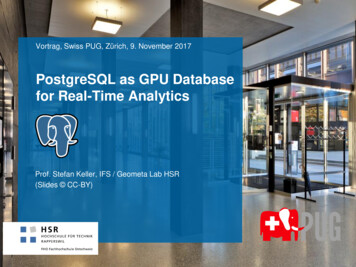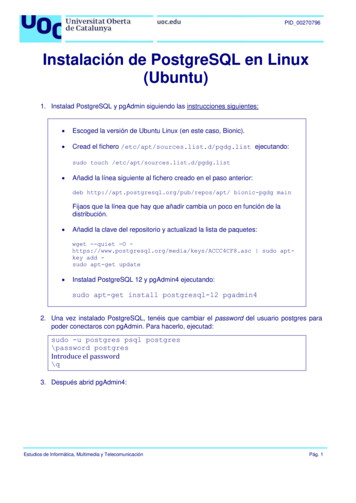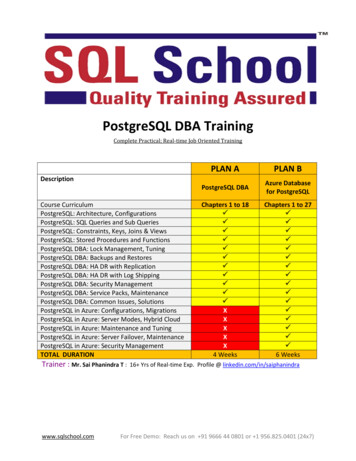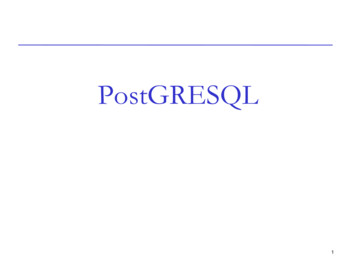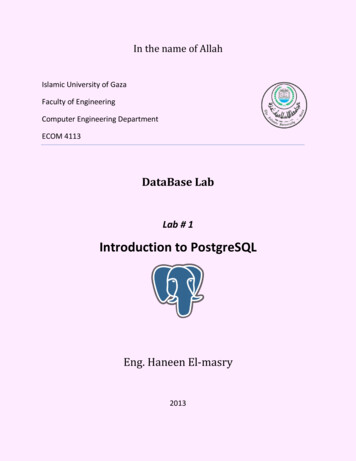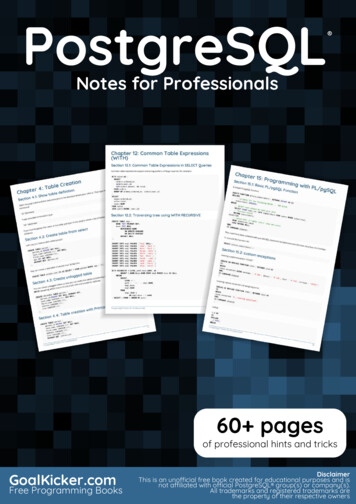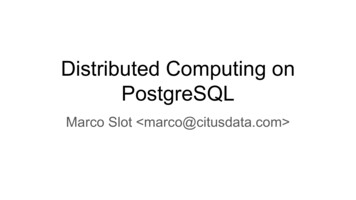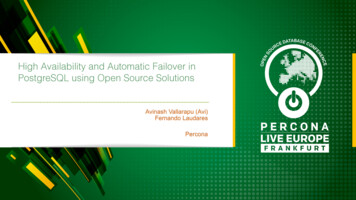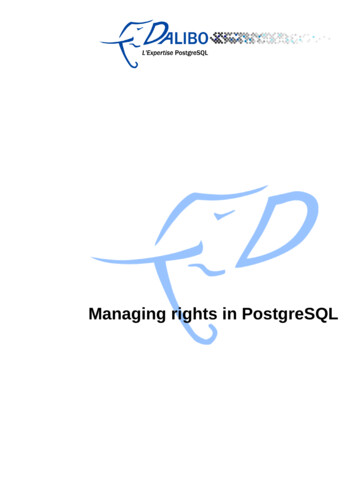
Transcription
Managing rights in PostgreSQL
Managing rights in PostgreSQLTable des matièresManaging rights in PostgreSQL.31 The author.32 Introduction.43 Users, groups and roles.43.1 Users and groups.53.2 Modifying a role.54 Special roles and role attributes.54.1 Superusers.64.2 The PUBLIC role.64.3 Attributes.64.4 Inheritance.64.5 Inheritance example.75 Default rights.76 How access is granted or denied.86.1 Host Based Access.86.2 Database connection attribute.86.3 The object hierarchy.96.4 Going through to a relation.96.5 Ownership.96.6 Special cases.106.7 Viewing rights.106.8 Granting and Revoking rigths.106.9 Securing the default installation.117 Default privilages.117.1 How default privileges work.117.2 The read only user.127.3 Other use cases.128 SE-PostgreSQL?.138.1 Prerequisites.138.2 Installation.138.3 Creating your policy.148.4 Current limitations.149 Conclusion.142 / 15
Managing rights in PostgreSQLManaging rights inPostgreSQL1 The author Auteur : Nicolas Thuvin Company : Dalibo Date : December 2011 URL : https://support.dalibo.com/kb/conferences/bla3 / 15
Managing rights in PostgreSQL2 IntroductionIn this talk : How rights works in PostgreSQL from connection to SQL statementexecution How to manage roles and rights Defaults privileges SE-PostgreSQL?I will try to show real world example whenever possible.3 Users, groups and roles Users are used to identify people accessing the db Groups allow to share rights between users Since 8.1, users and groups are roles A user is a role that can log in A group is a role that cannot log in4 / 15
Managing rights in PostgreSQL3.1 Users and groups To create a user:CREATE ROLE user name LOGIN ATTRIBUTES ; To create a group:CREATE ROLE group name NOLOGIN ATTRIBUTES ; To add a rôle to another:GRANT ROLE group name TO user name;3.2 Modifying a role ALTER ROLE For example, to set a password:ALTER ROLE postgres WITH PASSWORD 'new password';4 Special roles and role attributes Superusers The PUBLIC role Global modification attributes Inheritance5 / 15
Managing rights in PostgreSQL4.1 Superusers By default postgres, without a password (!) Can by given to any role using the SUPERUSER attribute:ALTER ROLE ROLE role name SUPERUSER;ALTER ROLE role name NOSUPERUSER; Superuser are god on the cluster, but: They must pass through Host Based Access (pg hba.conf) They cannot connect to a database with datallowconn set to false4.2 The PUBLIC role An implicit group everybody belongs to Has some default rights granted4.3 Attributes A set of global rights Superuser Inheritance Login, connection limit and validity Database, Role creation Columns of pg roles4.4 Inheritance Allow a role to get the rights of other roles granted to it directly or not Use of SET ROLE to obtain rights from other roles Protect the role from having too many rights all the time6 / 15
Managing rights in PostgreSQL4.5 Inheritance exampleHow to delegate superuser privileges without giving the password ofpostgres to others: Create a admins group with inheritance :CREATE ROLE admins NOLOGIN NOINHERIT; Create a admin account with no superuser rights:CREATE ROLE one admin LOGIN PASSWORD 'foobar'; Put one admin into admins group:GRANT admins TO one admin; Put admins into postgres:GRANT postgres TO admins;5 Default rightsAfter initdb: Local access only (listen addresses, pg hba.conf) Right to connect to any database but template0 CONNECT : connect to the database TEMP : create temporary tables Rights on the public schema USAGE : access the objects CREATE : create new objects Those default rights are granted to PUBLIC7 / 15
Managing rights in PostgreSQL6 How access is granted or denied Host Based Access The object hierarchy Going through to a relation Ownership6.1 Host Based Access Configuration done in pg hba.conf Define what authentication method will be asked for : A user (role with the LOGIN attribute) Who wants to connect to a database From a particular host (or the local Unix Domain socket) Access is granted when : A line matches AND the method is NOT reject AND the client correctly answer to authentication method Superusers cannot bypass this check The pg hba.conf file is walked from top to bottom, the server stopswhen a line matches or at the bottom6.2 Database connection attribute The database must allow connections datallowconn set to true in pg database Superusers cannot bypass this Exemple template08 / 15
Managing rights in PostgreSQL6.3 The object hierarchy6.4 Going through to a relationProvides HBA says ok and the database allows connections, the role:1. Must have the CONNECT right to the database2. Must have the USAGE on the schema containing the object3. Must have the ownership or right to access or modify the contents ofthe relation9 / 15
Managing rights in PostgreSQL6.5 Ownership The owner of an object can: Access and modify its contents Modify its structure Drop it provided it has the right to modify the parent object Someone who does not own an object: Cannot access/modify the contents unless a right is granted Cannot modify it definition (no rights exists for that) Can drop it if he/she owns the schema /!\6.6 Special cases Views: Rights needed to access them like any other relation The underlying query is executed with the rights of their owner Functions: Rights needed to execute them Can be executed with the priviliges of their owner (SECURITYDEFINER)6.7 Viewing rights *acl columms in tables of the system catalog, mainly: pg database: datacl Database rights (\l) pg namespace: nspacl Schema rights (\dn ) pg class: relacl Tables, Views and Sequences (\dp) pg proc: proacl Functions If empty, then default rights Format documented on the documentation of GRANT10 / 15
Managing rights in PostgreSQL6.8 Granting and Revoking rigths Use GRANT to give a right Use REVOKE to remove it The name of privileges depends on the target WITH GRANT OPTION allows the target role to give the right ALL keyword to give all rights ( 9.0) Give a role to another (manage membership) « \h GRANT » in psql remembers the details for you6.9 Securing the default installation1. Set a password for postgres:ALTER ROLE postgres WITH PASSWORD 'new password';2. Configure pg hba.conf to use the md5 method and reload3. Give ownership of databases to a non applicative role4. Revoke rights from the PUBLIC role:REVOKE ALL ON DATABASE db name FROM PUBLIC;REVOKE ALL ON SCHEMA public FROM PUBLIC;Then one can: Grant rights to applicative roles Setup default privileges to ease the management of rights7 Default privilages A way to automatically give rights at object creation Best used when included in the design Very powerful and can be life saving11 / 15
Managing rights in PostgreSQL7.1 How default privileges work ALTER DEFAULT PRIVILEGES FOR role IN SCHEMA nsp GRANT rightON objects TO other role When role: creates an object of the “objects” (table, sequence ) inside the nsp schema then right is automatically granted to other role on the new object use \ddp in psql to view default privileges7.2 The read only user There is always a boss who wants a read-only access How to solve that:CREATE ROLE readonly LOGIN PASSWORD 'some pass';-- Existing objectsGRANT CONNECT ON DATABASE the db TO readonly;GRANT USAGE ON SCHEMA public TO readonly;GRANT SELECT ON ALL TABLES IN SCHEMA public TO readonly;GRANT SELECT ON ALL SEQUENCES IN SCHEMA public TO readonly;GRANT EXECUTE ON ALL FUNCTIONS IN SCHEMA public TO readonly;-- New objectsALTER DEFAULT PRIVILEGES FOR ddl user IN SCHEMA public GRANT SELECT ON TABLES TOreadonly;ALTER DEFAULT PRIVILEGES FOR ddl user IN SCHEMA public GRANT SELECT ON SEQUENCESTO readonly;ALTER DEFAULT PRIVILEGES FOR ddl user IN SCHEMA public GRANT EXECUTE ON FUNCTIONSTO readonly;12 / 15
Managing rights in PostgreSQL7.3 Other use cases The best is to use different roles for managing the structure and thecontent: The owner takes care of the structure The owner has default privileges to let an application role modify thedata Default privileges can be used to clean rights before going toproduction: Setup the default privileges Restore dumps with pg restore -U ddl user -X -o8 SE-PostgreSQL? Allow to enhance security by asking SELinux if access can by granted toan object SELinux context is checked after regular privileges (like on the system) Can enforce the external policy up to the column (like regularprivileges)8.1 Prerequisites A SELinux enabled system, e.g. Linux only PostgreSQL 9.1 The sepgsql module (–with-selinux) The Reference Policy module for PostgreSQL loaded IPSec or some way to label what comes from the network Knowlegde on SELinux policy development13 / 15
Managing rights in PostgreSQL8.2 Installation Confine the PostgreSQL server on the Linux side: load the postgresql.pp SELinux Policy module (re)label the files of the PostgreSQL installation Load sepgsql at the cluster startup:shared preload libraries 'sepgsql' Create the SE-PostgreSQL functions inside the database:\i /path/to/contrib/sepgsql.sql;SELECT sepgsql-restorecon(NULL);8.3 Creating your policy The reference policy gives some interfaces for SELinux roles (seepostgresql.if) The reference policy gives examples on possible rights Use SECURITY LABEL statements to label the objects8.4 Current limitationsWith SE-PostgreSQL in 9.1: No labels for database No row level labels No Data Definition Language rights Unable to hide object existence, only the contents14 / 15
Managing rights in PostgreSQL9 Conclusion PostgreSQL features on privileges are rich The default installation is not so bad on the security side, and easilyhardened Default privileges ease the management of rights, when properly used And SE-PostgreSQL adds promising security features to PostgreSQL15 / 15
Managing rights in PostgreSQL 8.2 Installation Confine the PostgreSQL server on the Linux side: load the postgresql.pp SELinux Policy module (re)label the files of the PostgreSQL installation Load sepgsql at the cluster startup: shared_preload_libraries 'sepgsql' Create the SE-PostgreSQL functions inside the database:
